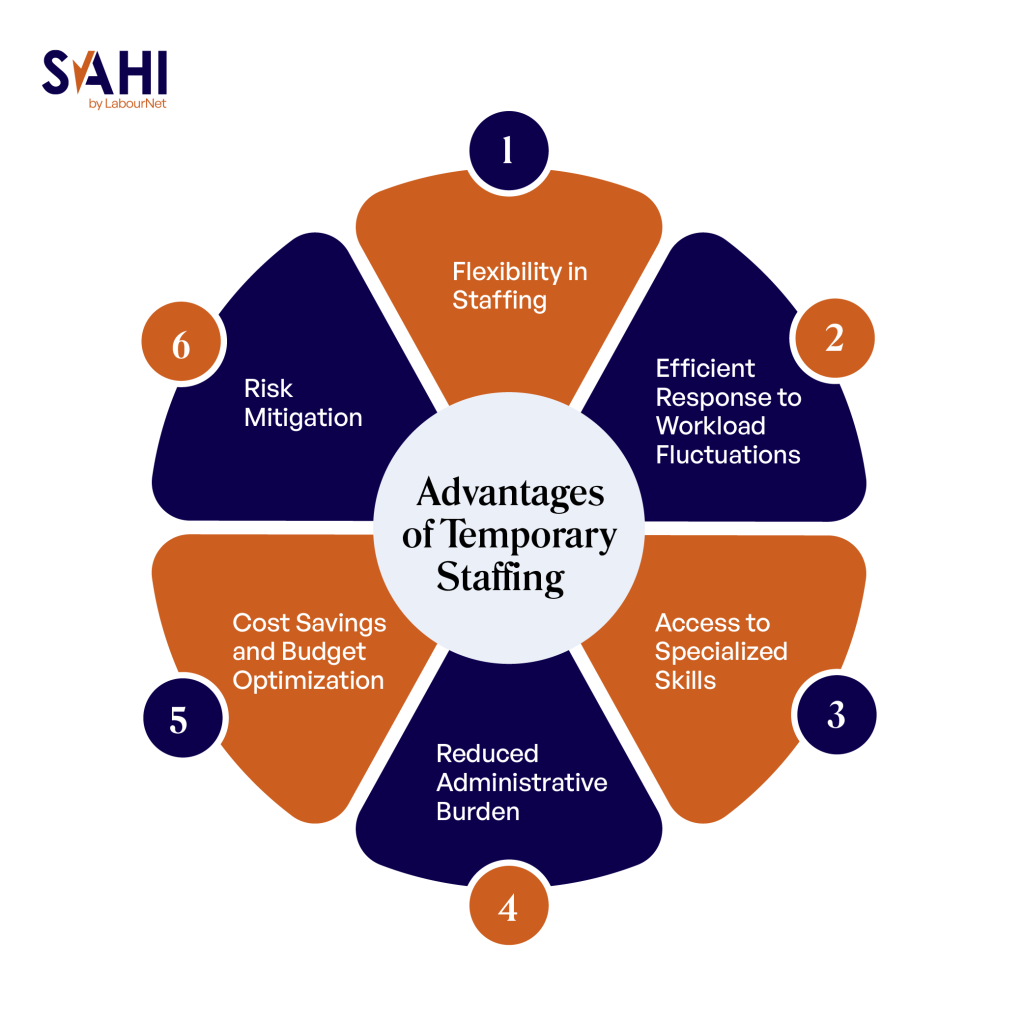Managing the workforce is a multifaceted challenge, especially when it comes to the distinctive dynamics of blue-collar and grey-collar workers. These two categories bring their own unique demands and intricacies that HR professionals must navigate effectively. As industries evolve and organizational needs shift, the demand for a workforce that is both adaptable and dependable has never been more pressing.
In response to these demands, temporary staffing solutions have emerged as a strategic solution that marries flexibility with reliability. The core concept revolves around the idea of addressing immediate workforce requirements while maintaining the agility to scale as needed. This comprehensive guide delves into the realm of temporary staffing solutions, shedding light on their applicability, benefits, and best practices within the context of blue-collar and grey-collar workforce management.
Understanding Workforce Categories: Blue-Collar and Grey-Collar
In the intricate landscape of workforce management, it’s essential to grasp the nuances of blue-collar and grey-collar workforces. These categories encompass roles that are the bedrock of various industries and form the operational backbone of organizations. Let’s delve into each category to gain a better understanding.
What is Blue-Collar Workforce?
Blue-collar workers are the hands-on force that keeps industries moving forward. They are skilled in technical trades and perform manual tasks that require physical prowess and expertise. Their responsibilities can range from operating machinery and equipment to assembling and constructing various structures. In essence, blue-collar workers are the craftsmen who bring tangible results to life.
What is Grey-Collar Workforce?
Grey-collar workers, on the other hand, blend both manual and cognitive skills. These roles demand a diverse skill set that combines technical proficiency with problem-solving capabilities. Grey-collar workers often find themselves troubleshooting complex machinery, offering technical support, and performing tasks that require a mix of hands-on skills and analytical thinking.
Key Differences Between Blue-Collar and Grey-Collar Workers
While both blue-collar and grey-collar workers contribute to the operational fabric of an organization, the key distinction lies in the nature of their tasks and skill requirements. Blue-collar workers excel in hands-on, technical tasks, whereas grey-collar workers bridge the gap between physical labor and cognitive skills. This contrast forms the foundation of their unique contributions to the workforce.
The Need for Temporary Staffing Solutions
In the realm of workforce management, where adaptability and efficiency reign supreme, the demand for temporary staffing solutions has soared. These solutions offer a dynamic response to the ever-changing requirements of modern organizations, providing a strategic advantage that aligns with the complexities of blue-collar and grey-collar workforces.
The Dynamic Nature of Workforce Requirements
Seasonal Demands: Industries often experience fluctuations in demand due to seasonal peaks. Temporary staffing allows organizations to seamlessly adjust their workforce during these high-demand periods, ensuring that customer needs are met without overburdening permanent staff.
Project-Specific Needs: Project-driven workloads require a flexible staffing approach. Temporary staffing enables organizations to swiftly assemble teams tailored to specific project requirements, ensuring optimal resource utilization.
Cost Considerations
Financial Benefits of Temporary Staffing: Temporary staffing solutions can significantly impact an organization’s bottom line. By only hiring when necessary, businesses can avoid the financial strain of maintaining a larger permanent workforce during quieter periods.
Reduced Overhead Costs: Temporary staff are often employed on a contract basis, which minimizes costs associated with benefits, training, and other overhead expenses that come with full-time employees.
Skill Requirements and Upskilling
Catering to Different Skill Sets: Temporary staffing solutions can be fine-tuned to cater to diverse skill requirements. Whether a project demands specialized technical skills or more generalized expertise, temporary staff can be chosen accordingly.
Opportunities for Upskilling: Temporary positions can serve as opportunities for workers to learn new skills or enhance existing ones. By upskilling temporary staff, organizations contribute to building a more versatile and skilled workforce.
Navigating the intricate landscape of workforce management demands a strategic approach that can accommodate the dynamic demands of blue-collar and grey-collar workforces. Temporary staffing solutions offer a solution that is not only responsive to these demands but also brings about financial benefits and skill development opportunities, all of which align seamlessly with SAHI’s mission to reimagine workforce management.

What are the Advantages of Temporary Staffing?
Temporary staffing solutions offer a myriad of benefits that can transform workforce management. Here are some key advantages to consider:
- Flexibility in Staffing: Temporary staffing provides the flexibility to scale your workforce up or down based on demand, ensuring optimal resource utilization.
- Efficient Response to Workload Fluctuations: Rapidly adjust your team size to match varying workloads, whether due to seasonal peaks or project-specific needs.
- Access to Specialized Skills: Tap into a pool of diverse talents, allowing you to address specialized tasks without the commitment of permanent hires.
- Reduced Administrative Burden: Temporary staffing agencies handle many administrative tasks, including recruitment, payroll, and benefits, freeing up your HR team’s time.
- Cost Savings and Budget Optimization: Minimize overhead costs associated with full-time employees, such as benefits and training, leading to significant cost savings.
- Risk Mitigation: Temporary staffing reduces the risks associated with long-term commitments, providing a buffer against uncertain economic conditions.
Leveraging these advantages, organizations can revitalize their workforce strategies, harnessing the power of temporary staffing to enhance agility, productivity, and overall operational efficiency.
Strategies and Best Practices for Effective Temporary Staffing
Crafting a successful temporary staffing strategy involves careful planning and execution. Let’s explore some best practices that can help organizations seamlessly integrate temporary staff into their workforce.
Understanding Staffing Needs
Initial Assessments: Begin by conducting a comprehensive evaluation of your workforce needs. Identify peak periods, project requirements, and skill gaps to determine when and where temporary staff can provide the most value.
Role Definitions: Clearly define the roles you intend to fill with temporary staff. Outline responsibilities, required skills, and performance expectations to ensure a smooth transition for both temporary and permanent team members.
Choosing the Right Temporary Staffing Services
Criteria for Selection: When partnering with temporary staffing agencies, consider factors beyond cost. Look for agencies with a proven track record in blue-collar and grey-collar staffing, along with a reputation for efficient and reliable placements.
Importance of Specialized Agencies for Blue-Collar and Grey-Collar Staffing: Given the unique skill sets and challenges of blue-collar and grey-collar roles, opting for specialized staffing agencies enhances the likelihood of finding the right candidates who align with your organization’s specific needs.
Implementation and Onboarding
Swift and Efficient Ways to Onboard Temporary Staff: A streamlined onboarding process is crucial for getting temporary staff up to speed quickly. Provide comprehensive orientation materials, job-specific training, and clear communication of expectations to ensure they hit the ground running.
Temporary staffing holds the potential to revolutionize workforce management when executed with precision. By understanding your organization’s staffing needs, selecting the right agency partners, and implementing efficient onboarding procedures, you can harness the power of temporary staff to boost productivity, address skill gaps, and navigate dynamic workload fluctuations.
Compliance Considerations and Risk Management
Effectively managing temporary staff involves not only optimizing operations but also adhering to legal and ethical standards. Let’s explore the compliance aspects and risk management strategies associated with temporary staffing.
Legal Aspects of Temporary Staffing
Employment Laws and Regulations: Temporary staffing must align with labor laws to ensure fair treatment and protect both temporary workers and the organization. Understanding regulations related to wages, working hours, and employment contracts is essential.
Contractual Obligations
Key Contract Elements to Pay Attention To: Contractual agreements with temporary staff and staffing agencies should be meticulously crafted. Pay attention to factors such as roles and responsibilities, compensation, termination clauses, and any intellectual property agreements.
Risk Mitigation Strategies
Ensuring a Secure Work Environment: Temporary staff, like any other employees, deserve a safe and healthy work environment. Implement safety protocols, provide proper training, and offer necessary protective equipment to mitigate workplace hazards.
Measures to Reduce Potential Liabilities: Organizations must have protocols in place to manage risks that could arise from accidents, injuries, or disputes involving temporary staff. Clear communication, timely reporting, and comprehensive insurance coverage are key components of effective risk mitigation.
Incorporating compliance considerations and robust risk management strategies is crucial when integrating temporary staff into your workforce. By aligning with legal standards, crafting well-defined contracts, and prioritizing safety, organizations can ensure a harmonious working relationship with their temporary workforce, minimizing potential liabilities along the way.
Enhancing Productivity Through Temporary Staffing
Temporary staffing isn’t just about addressing immediate workforce needs; it’s a strategic tool that can elevate the overall productivity of an organization. Let’s delve into how temporary staffing can be a catalyst for operational efficiency and team productivity.
Operational Efficiency
How Temporary Staffing Makes HR Operations More Efficient: Temporary staffing allows HR departments to swiftly adapt to changing workforce demands. By quickly sourcing skilled temporary workers, HR teams can streamline recruitment processes, saving time and resources while maintaining staffing levels optimized for productivity.
Team Productivity
Contribution to the Overall Productivity of the Organization: Temporary staff can inject fresh energy and expertise into teams. Their ability to dive into projects with specialized skills enhances the efficiency of teams, ensuring that projects are completed promptly and to the highest standards.
By strategically leveraging temporary staffing to enhance both HR operations and overall team productivity, organizations can maintain a competitive edge. The influx of specialized skills, combined with streamlined recruitment processes, can result in a more agile and productive workforce that’s well-equipped to tackle evolving challenges.
Cost-Effective Staffing Approaches
Amidst the pursuit of operational excellence, cost optimization remains a cornerstone. Temporary staffing introduces innovative approaches to minimize costs while maintaining a proficient workforce. Let’s explore how this strategy aligns with the objective of budget-friendly workforce management.
Budget-Friendly Solutions
Cost Optimization Strategies: Temporary staffing enables organizations to control labor costs effectively. By employing temporary staff during peak periods, businesses avoid the financial strain associated with permanent hires during quieter times.
Return on Investment
Long-Term Financial Benefits: The advantages of temporary staffing extend beyond short-term solutions. Investing in temporary staff can yield long-term returns, as their contributions enhance project outcomes, productivity, and the organization’s bottom line.
Potential of Temporary Staffing for Blue-Collar and Grey-Collar Workforces
Navigating the intricate landscape of blue-collar and grey-collar workforce management requires a dynamic and strategic approach. Temporary staffing solutions have emerged as a powerful tool that aligns seamlessly with the diverse demands of these workforce categories. Throughout this comprehensive guide, we’ve explored the fundamental concepts, advantages, best practices, compliance considerations, and the transformative impact of temporary staffing on productivity and skill development.
As HR Managers strive to build agile, efficient, and skilled workforces, temporary staffing presents an opportunity to reimagine workforce management. By understanding staffing needs, selecting specialized agencies, managing compliance, and fostering skill development, HR Managers can orchestrate a harmonious blend of temporary and permanent staff to drive organizational success.
In the ever-evolving world of business, the ability to adapt quickly and make informed decisions is paramount. Temporary staffing equips HR Managers with a strategic approach that empowers organizations to thrive amidst challenges and seize opportunities, fostering a dynamic and resilient workforce that embodies SAHI’s mission to reimagine workforce management.
FAQ
Q1: How can temporary staffing benefit blue-collar and grey-collar workforces?
Temporary staffing provides organizations with the flexibility to scale their workforce according to varying demands. It allows quick access to specialized skills, making it ideal for addressing the unique requirements of blue-collar and grey-collar roles. By bringing in temporary staff during peak periods or for specific projects, companies can optimize operational efficiency without committing to long-term hires.
Q2: What legal considerations should organizations keep in mind when implementing temporary staffing solutions?
When implementing temporary staffing solutions, organizations must adhere to employment laws and regulations. This involves ensuring fair treatment, appropriate compensation, and proper working conditions for temporary staff. Contracts should be carefully crafted to outline roles, responsibilities, and terms, while also considering intellectual property and non-compete agreements.
Q3: How can temporary staffing contribute to cost optimization for businesses?
Temporary staffing offers budget-friendly solutions by allowing organizations to hire staff on a per-need basis. During periods of increased demand, temporary staff can be brought in without incurring the long-term costs associated with permanent employees. This cost-efficient approach aligns with SAHI’s commitment to cost optimization while maintaining a skilled workforce.
Q4: What strategies can HR Managers implement to ensure successful onboarding of temporary staff?
HR Managers can ensure smooth onboarding of temporary staff by providing comprehensive orientation materials, clear job descriptions, and efficient training programs. Swift integration into the team and clear communication of expectations contribute to the temporary staff’s quick assimilation, allowing them to contribute effectively from day one.
Q5: How does upskilling temporary staff impact both employers and employees in blue-collar and grey-collar workforces?
Upskilling temporary staff benefits both employers and employees. For employers, upskilled temporary staff become more versatile assets, capable of handling a wider range of tasks. This improves overall operational flexibility. Temporary employees gain valuable skills that enhance their employability, contributing to their career growth and job satisfaction. This aligns with SAHI’s objective of fostering skill development and building an engaged workforce.


